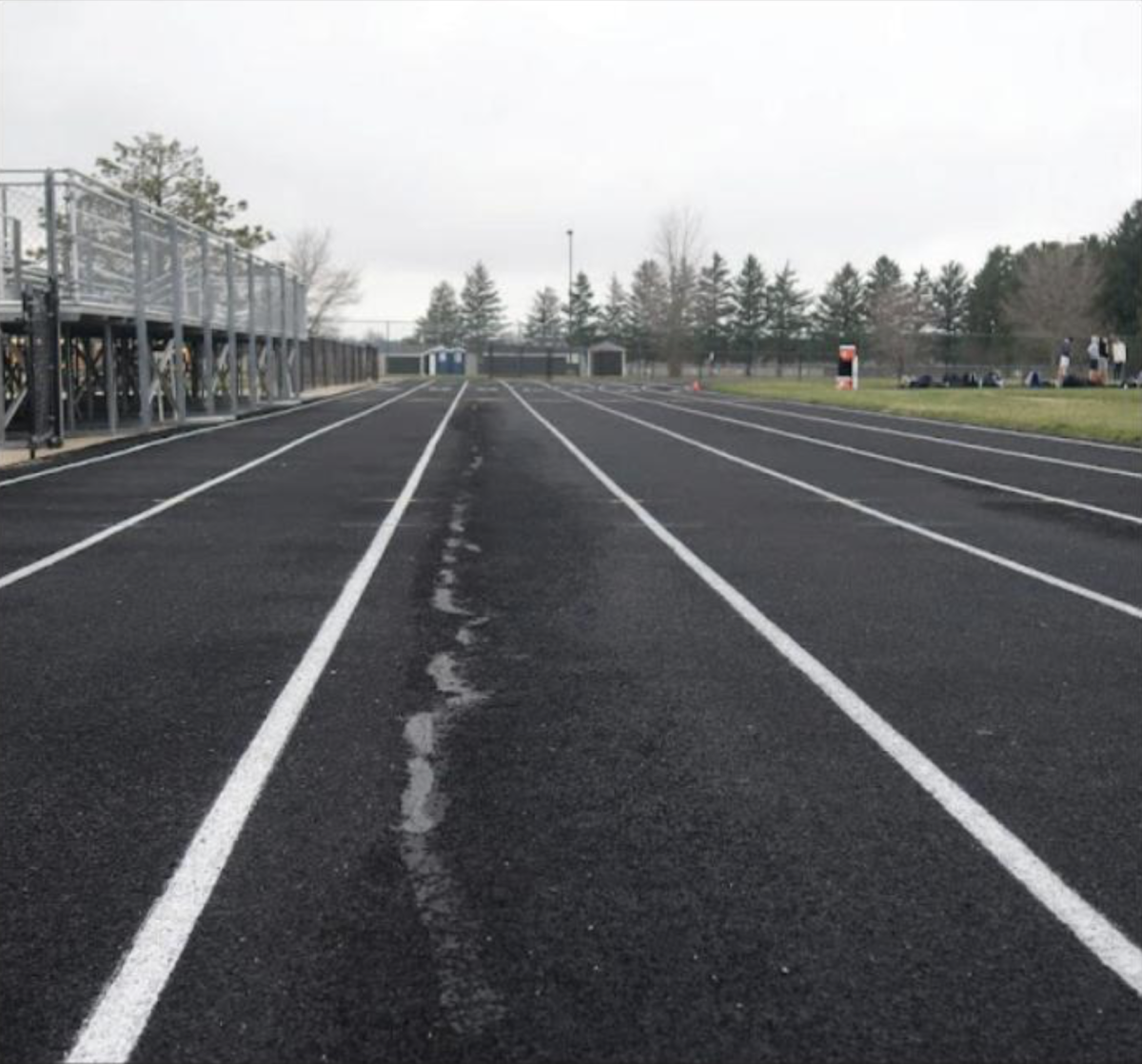Whether it’s rain or snow, Illinois isn’t known for their glamorous springs. But inconsistent weather doesn’t prevent kids from doing the things they love.
While the weather may be starting to improve, practicing outside can still be a challenge for certain sports. Not all facilities are up to date considering Kaneland’s age of 65, which is especially true for Kaneland’s track.
Though it may not be obvious to people who are unfamiliar with a track, Kaneland High School’s track has run its course. It’s been due for a makeover for many years now but has yet to get one.
Head boys track coach Andrew Drendel said the track was “the most unflat track I have ever seen in my entire life. And I’ve been to over 100 high schools in Illinois. Never seen anything like ours.”
The issue of the track predates Drendel’s time at Kaneland. Previous head girls track and field coach Eric Baron brought the track issue to the district in 2009, but there was no resolution to his concern.
Drendel described the track as bumpy and wavy, giving a ballpark estimate that only 40% of the track is actually flat. The track also has a variety of cracks throughout it, which are especially present on the home stretch. This past summer, Kaneland patched the cracks. This was a short-term solution to a long-term problem. The track is already showing evidence of re-cracking despite the recency of the repairs.
“When you’re sprinting at 100-meter speed…you get to [our track] and you come down on a little mound. What scares me is that they roll their ankle or something happens to their knee,” Drendel said. “Those are not track injuries. You should never sprain your ankle in track, and you should never have a knee problem. An ACL injury is not a track injury.”
The state of the track has an impact on how practices are run. The boys team avoids the 300-meter mark to the finish line at all costs. Instead, the sprinters stay near the 200-meter mark (the flattest part of the track). This is, however, unavoidable when it comes to meets.
With such predominant physical flaws, the track no longer becomes a question of quality or being a “good track” but a student safety issue. And this concern affects not only Kaneland athletes but also Kaneland meet attendees, most of whom are not aware of the problem.
Because Drendel wanted to get a fresh perspective on the track in order to figure out if it was eligible to host meets, he invited Head IHSA Track and Field Official Michael Powers to Kaneland. His perspective would help eliminate bias. Powers has been to every track in Illinois and referees national competitions at the collegiate level.
Last fall he came to Kaneland to observe the track.
“On arrival, I noticed that the track had deteriorated over the years,” Powers said. “I noticed that there was some ‘patch’ work done on the track…cracks in the track were filled in. And there were [still] numerous cracks to fill in around the track. The worst part of the track is on the final straightaway before the finish line. Some of those patch jobs were done where the athlete takes off and comes down for the hurdle races. That is my main concern.”
Powers expressed his disappointment, saying he considered Kaneland to be a “track school.” Powers claimed he wouldn’t give this title to many schools, but Kaneland has always hosted amazing meets over the years.
During Powers’ visit to Kaneland, Drendel made a point to stay off the track while Powers was observing so Drendel didn’t sway his opinion. Powers was out there for about an hour until he called Drendel over.
Drendel recalls this conversation, with Powers telling him, “‘It’s the worst track I’ve seen in 20 years.” The discussion steered towards the question of whether or not it is safe to host meets. Hesitantly, Kaneland personnel decided at that point that it wasn’t yet bad enough to be pushed over that edge.
“We’ve always said as coaches that it’s going to take a kid getting hurt for something to finally change,” Drendel stressed. “And unfortunately, that’s what happened.”
Runners wear spikes on their shoes, which provide extra grip while running. Sophomore Luke Gadomski was jogging in lane 5 when the spikes on his shoes got caught on the track, causing him to break both his hand and wrist.
“When I was slowing down after doing a drill, I just tripped and fell,” Gadomski said. “But it was actually my spike that got stuck in the track. That led to me falling with only my hands [to break my fall].”
It doesn’t take much for an accident like this to happen.
“I was pretty much at a jogging pace,” Gadomski emphasized.
Gathering the boys track team, Drendel asked them if they were comfortable competing on a track in this condition. Overall, the team was hesitant.
Drendel also contacted head coaches planning to compete in the annual Peterson Prep Invite. Each coach agreed that it would be safer to relocate the meet.
One coach in particular wrote, “I wouldn’t want my athletes competing on that surface in those conditions.”
Kaneland personnel determined that they would only practice on the track and cancel or relocate upcoming meets.
Kaneland Director of Athletics and Activities David Rohlman also expressed concern with Kaneland’s track. As AD, he is involved in discussions at the district level to give his input on what repairs are needed at the high school. For five and a half years, he has been advocating for the track repairs. But this fight goes back farther than that.
“Our facilities here at Kaneland for athletics are far behind what we need them to be,” Rohlman said.
The asphalt base underneath the track was laid in 1975. Usually these bases only last 30 years, meaning it is 19 years over that deadline. To fix the track, the district would have hire someone to dig up the foundation and replace it. Without necessary maintenance, massive bubbles and fissures that run across lanes can occur, and this is a problem Kaneland’s track currently faces. The physical track should be resurfaced every 8-10 years, but Kaneland’s was last resurfaced in 1997. Rohlman predicts that repairs for a completely new track, in total, will cost anywhere from 600,000-700,000 dollars.
Kaneland Harter Middle School resurfaced their track in 2018 when that track was only nine years old. This project cost $68,487. At that point, the high school’s track was already 21 years old.
“You should resurface your track every 8-10 years, and the middle school did, which is great. I just don’t understand how ours has not been touched in 27 years,” Drendel said.
Every year, Rohlman and Kaneland Principal Dr. James Horne meet with Associate Superintendent Dr. Julie-Ann Fuchs and Director of Buildings and Grounds Mark Payton to go over all capital improvements. These meetings involve plans for improvements years in advance. In these meetings, they rank the school’s needs on a scale of 1-3. If a project is classified as a 1, it means that it is the highest priority and needs to be fixed. If a project is a 3, it needs to be fixed, but other things are more important.
“[The track] is categorized as a 1, and it has been for quite some time now…One thing that we have done – not me personally but we as a district have done – is we’ve continued to put off that track,” Rohlman said.
Currently, the district has a plan set for 2028 to dig up the foundation of the track, but this is not the first time the district has announced plans for improvements. They have had similar plans in 2013, 2016, 2019 and 2023. The track has been taken off the capital improvement plans four times in the last 15 years.
On June 22, 2022, the Approval of Capital Projects for the summer of 2023 showed that previous plans to reconstruct the track changed to recoating the surface.
When it became clear to coaches and the community that the proposed renovations would not be happening, Drendel spoke to the board on May 8, 2023, about the caved-in concrete and long cracks. He also expressed concern about how spikes would adapt to the filled-in cracks, a concern that came to fruition this year. Jennifer Farmer, a parent of a former track athlete, voiced similar complaints at this meeting, talking about shared safety concerns for her son and other athletes.
While the capital improvements plan from 2022 did lead to many of the track’s cracks being filled in, this is not a permanent solution.
“We did some repairs last fall, and they’re already not holding up. And we had a fairly light winter,” Rohlman said.
And once again, fixing the track was in conversations to be done this summer. But the board decided that the bus lot will be repaved instead.
“We’ve pushed it off and pushed it off way longer than we can,” Rohlman said. “We can’t keep doing it.”








